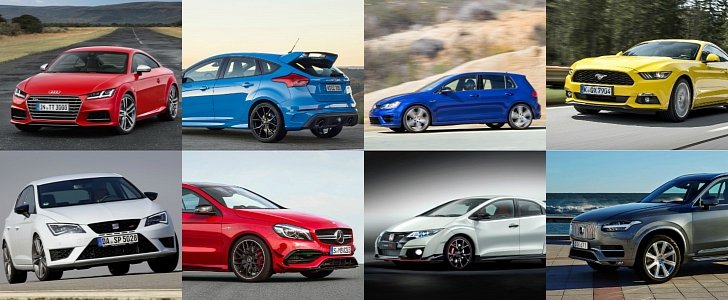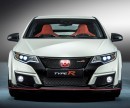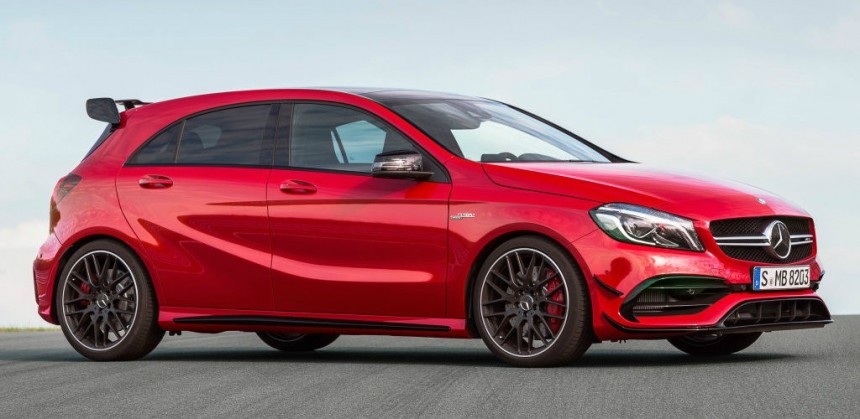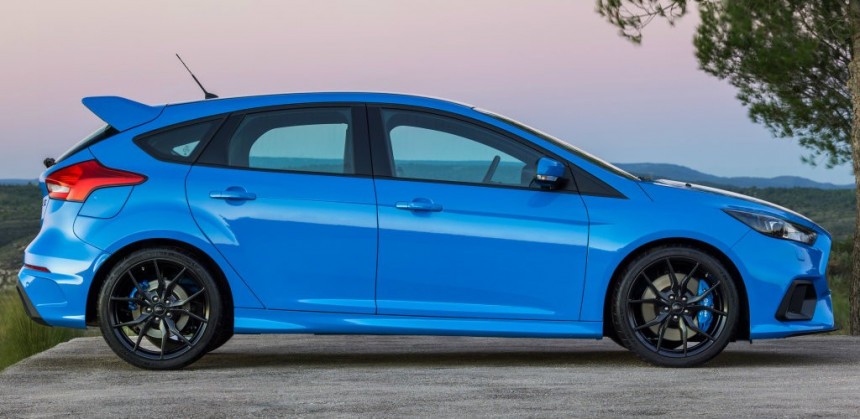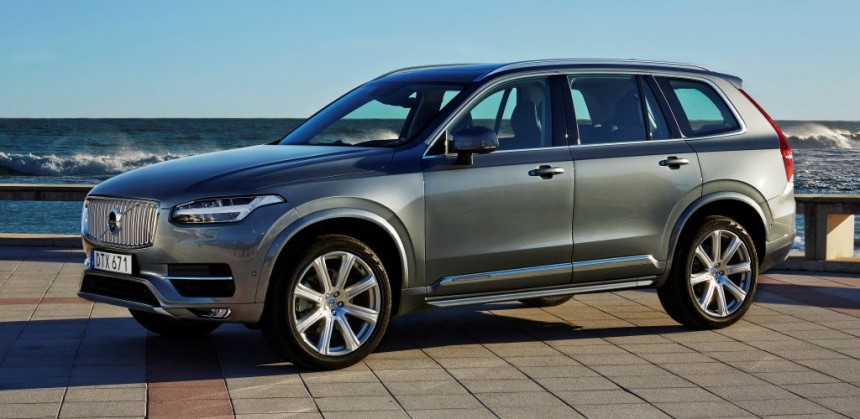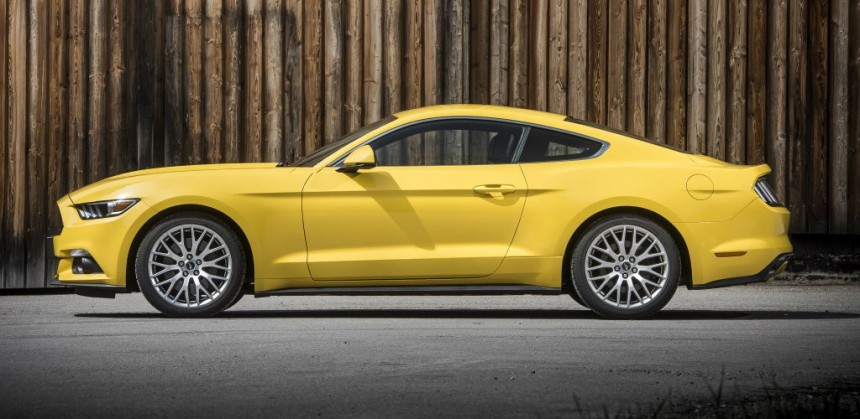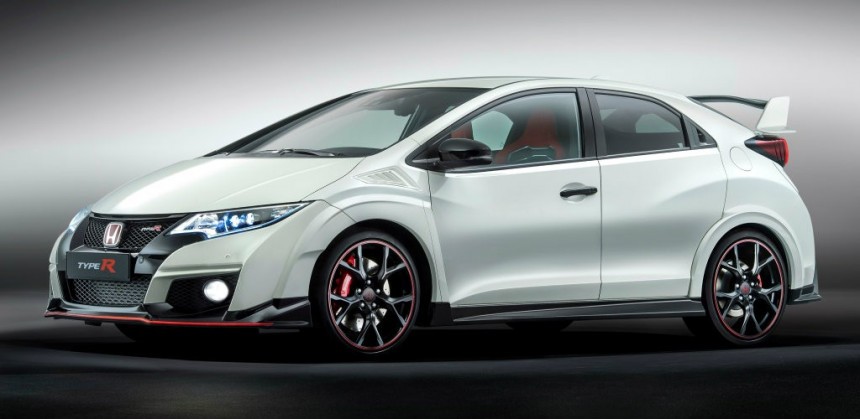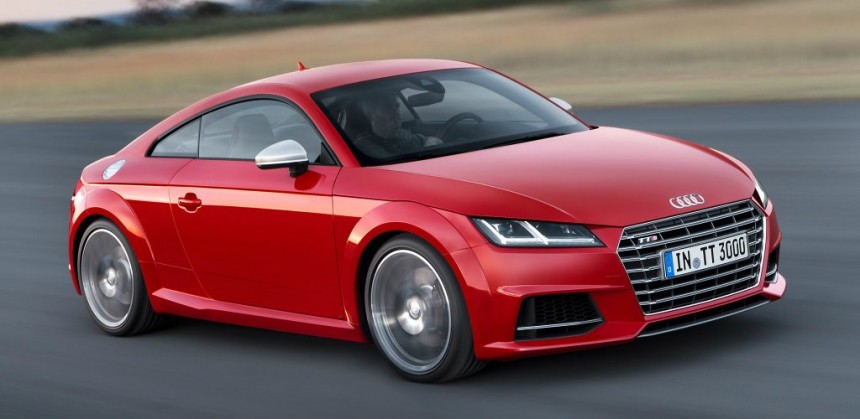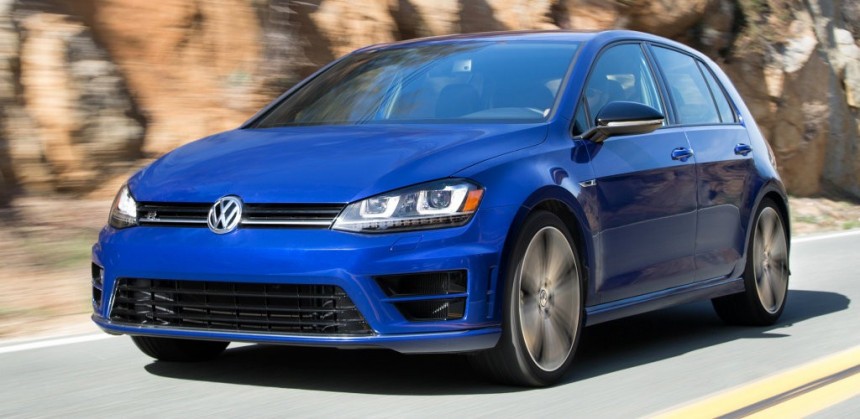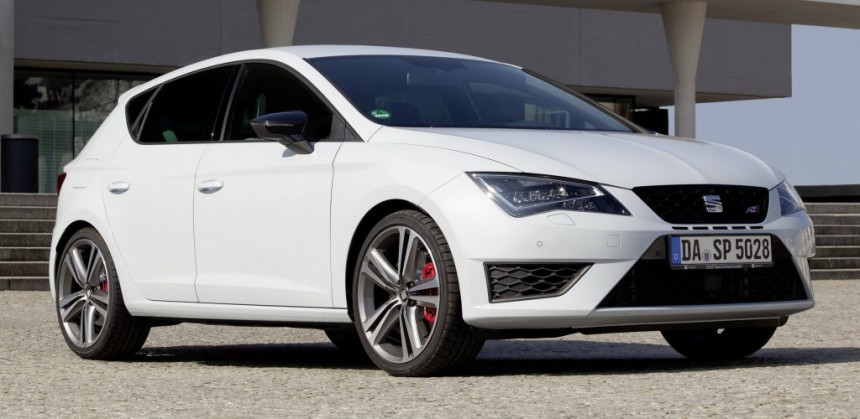If you’ll excuse the innuendo in the title, let’s get this straight from the get-go: when it comes to modern cars, the engine size doesn’t matter that much anymore. Thanks to contemporary advances in automotive engineering, the most powerful four-cylinder engine to equip a road-legal car has the upper hand over supercars we used to dream of.
One important reason for the four-cylinder engine’s coming of age is downsizing. At the forefront of downsizing stands the 1.0-liter EcoBoost. Yes, I know this is a three-banger. But this little hamster wheel can be tuned to produce 140 PS. That’s 138 horsepower for the North American public and it’s as impressive as a three-cylinder engine gets. To make a long story short, the 1.0 EcoBoost showed us and the automotive world that downsizing is power to the people.
Wizardry such as two-stage turbocharging, variable geometry, direct injection, is what true empowerment is for people who can’t afford or don’t need more cylinders under the hood of their daily drivers. But the truth is that downsizing isn’t just about more miles per gallon and more horsepower. In a rare instance, two seemingly conflicting goals have been bettered by government regulations.
Other than offering maximum smiles per gallon, four-cylinder engines can also be tuned by manufacturers to extreme outputs. A case in point is the head honcho of the hot hatchback genre, the first car in our ranking of the most powerful four-cylinder cars in 2016.
2016 Mercedes-AMG A 45
The three-pointed star and its skunkworks division are regarded by many as the rule breakers of the performance game. Accordingly, the Mercedes-AMG A 45 is the most powerful series-produced four-cylinder passenger car in the world, along with its platform brothers known as the GLA45, CLA 45 and CLA 45 Shooting Brake. With 381 PS (376 horsepower) and 475 Nm (350 lb-ft) of torque, this all-wheel-drive pocket rocket outguns the hero car of my childhood - the 1994 Ferrari 355 (F129).
Remember that glorious Pininfarina body shell and the howling of the mid-mounted 3.5-liter V8 with 5 valves per cylinder? It’s funny how the most high-performance eight-cylinder engine of that era is now rendered obsolete by a four-cylinder the size of a carton of milk.
The aural pleasure of the Ferrari Tipo F129B V8 is something I will never get over, but the grown-up inside me knows that the M133 engine of the Mercedes-AMG A 45 is a superior package. The result of wrapping a hatchback around such an engine? 4.2 seconds to 100 km/h (62 mph) and a top speed limited to 250 km/h (155 mph).
Unfortunately, no. The Audi RS3 Sportback has been left out of our list because the 2.5 TFSI is a five-cylinder engine. That’s why the Ford Focus RS and its 2.3 EcoBoost inline-four take second place in the ranking with 350 PS (345 horsepower) and 470 Nm (346 lb-ft).
Compared to the 2.3 EcoBoost of the Ford Mustang, the motor that animates the Focus RS delivers more goodies thanks to minor upgrades. The most important enhancements include a low-inertia twin-scroll turbo with a larger compressor for greater air flow, bigger intercooler, less restrictive intake, and a large-bore exhaust system.
The displacement and go-faster augmentation propel the RS to 100 km/h (62 mph) in 4.7 seconds and on to a top end of 266 km/h (165 mph). Just like the Mercedes-AMG A 45, Ford engineers gave the Focus RS an all-wheel-drive system for better driving dynamics. The icing on the cake, however, is called Drift Mode. Yes, ladies and gents, the Ford Focus RS is the only hot hatch with such a feature.
Surprise! The third most powerful four-cylinder car that made the list is a mid-size luxury crossover SUV with seating for seven. For the second-generation Volvo XC90, engineers decided to pour their talent and know-how into designing a range of four-cylinder engines marketed as Drive-E. The pick of the bunch comes in the form of the T6, a mill aided by turbocharging and supercharging.
The two philosophically opposed forced induction solutions posed some issues during development. The biggest problem was getting a turbocharger and supercharger to work together. The second was to make them work together in a refined manner because the Volvo XC90 T6 has to be as civilized as possible.
One of the most famous vehicles to be both turbocharged and supercharged is the Lancia Delta S4 Group B rally car and, as you may already know, that’s an extremely loud and uncomfortable car. The 2.0-liter engine of the Volvo XC90 T6 is tuned to produce 320 PS (315 horsepower) and 295 lb-ft (400 Nm) of torque, which is enough for this gentle giant to sprint to 100 km/h (62 mph) in 6.5 seconds.
Remember the Fox Body Mustang? Yeah, the generation that introduced turbocharging to the pony’s engine options. From 132 to 205 horsepower in its final iteration, the turbo-four ushered in a new performance era. Fast-forward to the S550 Mustang and the 2.3-liter turbo is back. Curiously enough, the 2.3 EcoBoost engine acts as the in-betweener of the range. This should raise an eyebrow or two, especially if you consider that the sixth-generation Chevrolet Camaro lineup starts with a model animated by a 2.0-liter turbo-four.
Though not as potent as the 2.3 EcoBoost in the Ford Focus RS, the motor under the hood of the Mustang is no slouch. 314 PS (310 horsepower) and 320 Nm (236 lb-ft) on 93-octane gas should do the trick. It might be small in displacement, but the little engine has been unanimously praised for delivering the right kind of kicks.
A broad and flat torque curve is the defining asset of the 2.3 EcoBoost, an asset needed for hustling down canyon roads and effortlessly passing on the highway. The sound it makes isn’t too shabby either, although nothing can replace the burble of a V8.
Without a shadow of a doubt, the most keenly anticipated hot hatchback in recent years is the current-gen Honda Civic Type R. And yes, this is a hot hatchback in name and nature alike because it’s front-wheel-drive. Wait, scrap that. The Civic Type R is the most powerful front-wheel-drive compact hatchback on the market today.
The aggressive exterior aesthetics and focused cabin design are complemented by the 2.0-liter VTEC Turbo under the hood. Its peak output is 310 PS (305 horsepower) and 400 Nm (295 lb-ft). Other than the engine, the second strongest point of the Type R comes in the guise of a helical limited-slip differential. This type of diff is designed to offer as much cornering traction as possible.
Thanks to its top-shelf engine and differential, the Honda Civic Type R lapped the 20.8-kilometer (12.9-mile) long Nurburgring in a staggering 7 minutes and 50.63 seconds. To put it into perspective, that’s faster than a 2009 Mercedes-Benz SL65 AMG Black Series.
Available as a coupe or as a roadster, the latest generation of the Audi TT is taut, muscular, and authentically fast if you go for the TTS model. The S badge signifies something special, which is why the business end of the German supermodel is a 2.0 TFSI engine with 310 PS (306 horsepower) and 380 Nm (280 lb-ft) of torque.
0 to 62 mph (100 km/h) is doable in 4.6 seconds provided that you go for the lighter coupe body style with the six-speed S tronic automatic transmission. In its quest to carve up the bends, the TTS is aided by the latest evolution of the quattro permanent all-wheel-drive system with an electrohydraulic multi-plate clutch arrangement.
The low weight of the Audi TTS also helps with the performance credentials of the German plaything. Tipping the scales at just 1,365 kilograms (3,009 lbs), the Audi TTS is lighter than the benchmark of this segment - the Porsche Cayman and its flat-six tower-of-power.
Forget the GTI. An R right after Golf means business. For those who want the fastest Volkswagen Golf around, the best bang for the buck is the R. I’ll give you that it’s top dollar for a compact hatchback with performance credentials, but then again, it’s worth every penny.
The ultimate expression of the most popular hatchback in the world is motivated by a 2.0 TSI. 300 PS (296 horsepower) and 380 Nm (280 lb-ft) are sent to the wheels via a 4MOTION AWD system with a fifth-generation Haldex coupling. The advantage of a Haldex system is that the all-wheel-drive system activates before the wheel starts to slip. This means that we’re dealing with a proactive system.
When equipped with the six-speed DSG, the Volkswagen Golf R is able to reach 100 km/h (62 mph) in 4.9 seconds. At the end of the day, the Golf R is a great overall package because it perfectly combines the practicality of a compact hatchback with the fun factor of a powerful engine, a supple chassis, and an understated design.
SEAT Leon Cupra 290
It’s hard to say this without getting flamed for it, but SEAT has always been the brand that nearly could. Nearly is a defining word for SEAT considering that its model range is a reinterpretation of whatever there’s available in the Volkswagen parts bin. Nearly as good as the Golf is what most think about the Leon, but then again, the SEAT Leon looks much better than the Volkswagen Golf Mk7.
The SEAT Leon Cupra, on the other hand, needs no excuses. Think of it as the more talented brother of the Golf GTI. Dubbed “the perfect car for enjoying a dynamic lifestyle,” the Leon Cupra in 290 guise is animated by a 2.0 TSI with dual injection and 290 PS (286 horsepower). The 350 Nm (258 lb-ft) it produces are mirrored by the torque figure of the Golf GTI. Available from 1,700 to 5,800 rpm, the engine of the Leon Cupra 290 guarantees pulling power.
A front-axle differential lock keeps the torque in check. The unit is hydraulically actuated and, in the most hell-bent for leather scenarios, it sends 100 percent of the goods to one wheel. Despite the fact that it’s last in the ranking, the Cupra 290 is an important layer of polish to one of the best names in the segment.
Wizardry such as two-stage turbocharging, variable geometry, direct injection, is what true empowerment is for people who can’t afford or don’t need more cylinders under the hood of their daily drivers. But the truth is that downsizing isn’t just about more miles per gallon and more horsepower. In a rare instance, two seemingly conflicting goals have been bettered by government regulations.
Other than offering maximum smiles per gallon, four-cylinder engines can also be tuned by manufacturers to extreme outputs. A case in point is the head honcho of the hot hatchback genre, the first car in our ranking of the most powerful four-cylinder cars in 2016.
2016 Mercedes-AMG A 45
The three-pointed star and its skunkworks division are regarded by many as the rule breakers of the performance game. Accordingly, the Mercedes-AMG A 45 is the most powerful series-produced four-cylinder passenger car in the world, along with its platform brothers known as the GLA45, CLA 45 and CLA 45 Shooting Brake. With 381 PS (376 horsepower) and 475 Nm (350 lb-ft) of torque, this all-wheel-drive pocket rocket outguns the hero car of my childhood - the 1994 Ferrari 355 (F129).
Remember that glorious Pininfarina body shell and the howling of the mid-mounted 3.5-liter V8 with 5 valves per cylinder? It’s funny how the most high-performance eight-cylinder engine of that era is now rendered obsolete by a four-cylinder the size of a carton of milk.
The aural pleasure of the Ferrari Tipo F129B V8 is something I will never get over, but the grown-up inside me knows that the M133 engine of the Mercedes-AMG A 45 is a superior package. The result of wrapping a hatchback around such an engine? 4.2 seconds to 100 km/h (62 mph) and a top speed limited to 250 km/h (155 mph).
2016 Ford Focus RS
Unfortunately, no. The Audi RS3 Sportback has been left out of our list because the 2.5 TFSI is a five-cylinder engine. That’s why the Ford Focus RS and its 2.3 EcoBoost inline-four take second place in the ranking with 350 PS (345 horsepower) and 470 Nm (346 lb-ft).
Compared to the 2.3 EcoBoost of the Ford Mustang, the motor that animates the Focus RS delivers more goodies thanks to minor upgrades. The most important enhancements include a low-inertia twin-scroll turbo with a larger compressor for greater air flow, bigger intercooler, less restrictive intake, and a large-bore exhaust system.
The displacement and go-faster augmentation propel the RS to 100 km/h (62 mph) in 4.7 seconds and on to a top end of 266 km/h (165 mph). Just like the Mercedes-AMG A 45, Ford engineers gave the Focus RS an all-wheel-drive system for better driving dynamics. The icing on the cake, however, is called Drift Mode. Yes, ladies and gents, the Ford Focus RS is the only hot hatch with such a feature.
Volvo XC90 T6
Surprise! The third most powerful four-cylinder car that made the list is a mid-size luxury crossover SUV with seating for seven. For the second-generation Volvo XC90, engineers decided to pour their talent and know-how into designing a range of four-cylinder engines marketed as Drive-E. The pick of the bunch comes in the form of the T6, a mill aided by turbocharging and supercharging.
The two philosophically opposed forced induction solutions posed some issues during development. The biggest problem was getting a turbocharger and supercharger to work together. The second was to make them work together in a refined manner because the Volvo XC90 T6 has to be as civilized as possible.
One of the most famous vehicles to be both turbocharged and supercharged is the Lancia Delta S4 Group B rally car and, as you may already know, that’s an extremely loud and uncomfortable car. The 2.0-liter engine of the Volvo XC90 T6 is tuned to produce 320 PS (315 horsepower) and 295 lb-ft (400 Nm) of torque, which is enough for this gentle giant to sprint to 100 km/h (62 mph) in 6.5 seconds.
Ford Mustang 2.3 EcoBoost
Remember the Fox Body Mustang? Yeah, the generation that introduced turbocharging to the pony’s engine options. From 132 to 205 horsepower in its final iteration, the turbo-four ushered in a new performance era. Fast-forward to the S550 Mustang and the 2.3-liter turbo is back. Curiously enough, the 2.3 EcoBoost engine acts as the in-betweener of the range. This should raise an eyebrow or two, especially if you consider that the sixth-generation Chevrolet Camaro lineup starts with a model animated by a 2.0-liter turbo-four.
Though not as potent as the 2.3 EcoBoost in the Ford Focus RS, the motor under the hood of the Mustang is no slouch. 314 PS (310 horsepower) and 320 Nm (236 lb-ft) on 93-octane gas should do the trick. It might be small in displacement, but the little engine has been unanimously praised for delivering the right kind of kicks.
A broad and flat torque curve is the defining asset of the 2.3 EcoBoost, an asset needed for hustling down canyon roads and effortlessly passing on the highway. The sound it makes isn’t too shabby either, although nothing can replace the burble of a V8.
Honda Civic Type R
Without a shadow of a doubt, the most keenly anticipated hot hatchback in recent years is the current-gen Honda Civic Type R. And yes, this is a hot hatchback in name and nature alike because it’s front-wheel-drive. Wait, scrap that. The Civic Type R is the most powerful front-wheel-drive compact hatchback on the market today.
The aggressive exterior aesthetics and focused cabin design are complemented by the 2.0-liter VTEC Turbo under the hood. Its peak output is 310 PS (305 horsepower) and 400 Nm (295 lb-ft). Other than the engine, the second strongest point of the Type R comes in the guise of a helical limited-slip differential. This type of diff is designed to offer as much cornering traction as possible.
Thanks to its top-shelf engine and differential, the Honda Civic Type R lapped the 20.8-kilometer (12.9-mile) long Nurburgring in a staggering 7 minutes and 50.63 seconds. To put it into perspective, that’s faster than a 2009 Mercedes-Benz SL65 AMG Black Series.
Audi TTS
Available as a coupe or as a roadster, the latest generation of the Audi TT is taut, muscular, and authentically fast if you go for the TTS model. The S badge signifies something special, which is why the business end of the German supermodel is a 2.0 TFSI engine with 310 PS (306 horsepower) and 380 Nm (280 lb-ft) of torque.
0 to 62 mph (100 km/h) is doable in 4.6 seconds provided that you go for the lighter coupe body style with the six-speed S tronic automatic transmission. In its quest to carve up the bends, the TTS is aided by the latest evolution of the quattro permanent all-wheel-drive system with an electrohydraulic multi-plate clutch arrangement.
The low weight of the Audi TTS also helps with the performance credentials of the German plaything. Tipping the scales at just 1,365 kilograms (3,009 lbs), the Audi TTS is lighter than the benchmark of this segment - the Porsche Cayman and its flat-six tower-of-power.
Volkswagen Golf R
Forget the GTI. An R right after Golf means business. For those who want the fastest Volkswagen Golf around, the best bang for the buck is the R. I’ll give you that it’s top dollar for a compact hatchback with performance credentials, but then again, it’s worth every penny.
The ultimate expression of the most popular hatchback in the world is motivated by a 2.0 TSI. 300 PS (296 horsepower) and 380 Nm (280 lb-ft) are sent to the wheels via a 4MOTION AWD system with a fifth-generation Haldex coupling. The advantage of a Haldex system is that the all-wheel-drive system activates before the wheel starts to slip. This means that we’re dealing with a proactive system.
When equipped with the six-speed DSG, the Volkswagen Golf R is able to reach 100 km/h (62 mph) in 4.9 seconds. At the end of the day, the Golf R is a great overall package because it perfectly combines the practicality of a compact hatchback with the fun factor of a powerful engine, a supple chassis, and an understated design.
SEAT Leon Cupra 290
It’s hard to say this without getting flamed for it, but SEAT has always been the brand that nearly could. Nearly is a defining word for SEAT considering that its model range is a reinterpretation of whatever there’s available in the Volkswagen parts bin. Nearly as good as the Golf is what most think about the Leon, but then again, the SEAT Leon looks much better than the Volkswagen Golf Mk7.
The SEAT Leon Cupra, on the other hand, needs no excuses. Think of it as the more talented brother of the Golf GTI. Dubbed “the perfect car for enjoying a dynamic lifestyle,” the Leon Cupra in 290 guise is animated by a 2.0 TSI with dual injection and 290 PS (286 horsepower). The 350 Nm (258 lb-ft) it produces are mirrored by the torque figure of the Golf GTI. Available from 1,700 to 5,800 rpm, the engine of the Leon Cupra 290 guarantees pulling power.
A front-axle differential lock keeps the torque in check. The unit is hydraulically actuated and, in the most hell-bent for leather scenarios, it sends 100 percent of the goods to one wheel. Despite the fact that it’s last in the ranking, the Cupra 290 is an important layer of polish to one of the best names in the segment.
